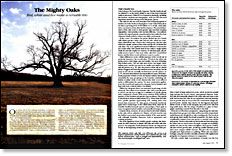
Synopsis: Oak’s role in the modern world may be somewhat less romantic than in years past, writes Jon Arno, but it has not diminished. It remains our most-used hardwood for interior trim, cabinets, flooring, furniture, and heavy construction applications. Arno examines the diversity of the timbers lumped together botanically as oak and he explores the primary factors that make oak so popular: its abundance and its utility. He offers tips on which oak to use when, breaking it down among its white, red, and live categories. And he offers side information on the benefits and drawbacks of tannin.
Our senses tell us it is nothing more than a coarse-textured wood with showy rays and a harsh acidic scent. Yet there’s something about oak that causes most of us to think of it in human terms: bold, strong and dependable. There can be little doubt why.
These trees, their fruit and their timber, are an inseparable part of the story of humanity. Acorns predated grain in the diet of our Stone-Age European ancestors. The pagan Germans worshipped oak, and in England, dense groves of the European white oak, Quercus robur, served as holy places for Druid rites well before written history began. From ancient times until just before our grandfathers were born, oak served as a strategic military and economic commodity, being the primary naval timber for ships of the line and tall Yankee clippers.
Oak’s role in the modern world may be somewhat less romantic, but it has not diminished. Oak remains our mostused hardwood for interior trim, cabinets, flooring, furniture and for many heavy construction applications. The two primary factors that have made oak so enduringly popular are its abundance and its utility. Before exploring these topics, though, let’s examine the great diversity of the timbers we lump together botanically as oak.
Oak’s family tree
Oaks belong to the beech family, Fagaceae. That this family should be referred to as the beech family is one of the more irrational snubs in taxonomy. Of the 600 or so species in the family, including the beeches, chestnuts and chinquapins, well over 500 of its most important members belong to the oak genus, Quercus.
The oaks are also the most abundant and widespread genus of hardwoods in the Northern Hemisphere. In the United States alone we have a growing stock of 100 billion cu. ft. of oak—more than twice our reserves of any other hardwood genus. The natural abundance of the oaks is due to their genetic vigor and their resulting adaptability. Oaks hybridize with very little difficulty. Over millions of years, this natural, genetic experimentation has resulted in a host of species ideally suited to almost any viable environment.
From Fine Woodworking #101
For the full article, download the PDF below:
Fine Woodworking Recommended Products

DeWalt 735X Planer

AnchorSeal Log and Lumber End-Grain Sealer

Ridgid R4331 Planer






















Log in or create an account to post a comment.
Sign up Log in